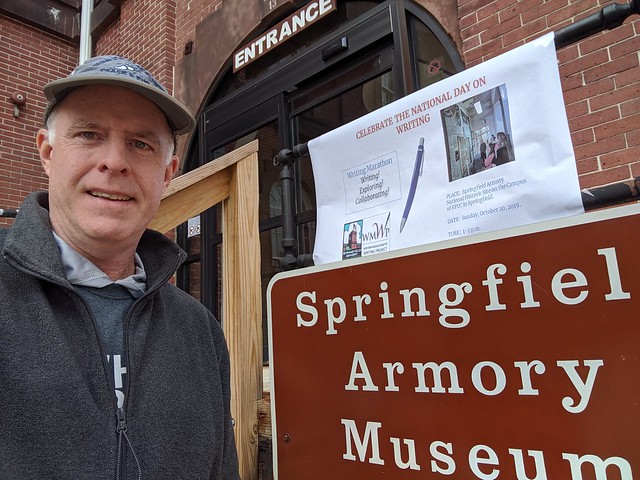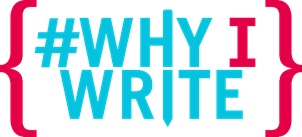This was for the National Day on Writing yesterday, as I focused this year on the Why I Write question towards poetry.
Peace (and poems),
Kevin
 (This is for the Slice of Life challenge, hosted by Two Writing Teachers. We write on Tuesdays about the small moments in the larger perspective … or is that the larger perspective in the smaller moments? You write, too.)
(This is for the Slice of Life challenge, hosted by Two Writing Teachers. We write on Tuesdays about the small moments in the larger perspective … or is that the larger perspective in the smaller moments? You write, too.)
I helped organize and facilitate a writing marathon for the National Day on Writing and Write Out on Sunday at the Springfield Armory National Historic Site, and like the 18 educators who signed up to take part in the event, I wrote my way throughout the afternoon, inspired by the museum and its archives. We had themed inspiration stations set up around the Armory to help spark ideas.
You can sense in my writing some the tension behind being inside a historical place that made the weapons that helped the US win wars through guns and arms. This is a tension I always feel when running programs for teachers and summer camps for middle school students at the Springfield Armory. I once wrote about this idea and titled it What To Do When Your Classroom is Filled with Guns.
Here are snippets and rough pieces of mine from each of the writing areas.
Special Photo Exhibit
The Welder
Obscured by
flames and fire —
the welder molds
iron and steel
into arms —
the camera rebels
the bright heat light
shrouded by aura,
and those of us who watch
from time and distance
only notice the moment,
frozen
Industry Display: Worker Group Photo
Dear Women of the Armory,
Thank you. I’m sure stepping into a national arms manufacturing plant — with the world at war and no end in sight — could not have been an easy choice. Maybe even you had your doubts — about war, about guns, about your own skills. I am sure Society’s story of you until now, as a woman, was at home, not here, but events forced Society’s hand. And you answered the call. You learned a complicated, intricate job. You were part of a team. You made a difference. Who knows what price you paid. Did you leave children each day or night at home to come here? Did you have a husband at war, always on your mind? Did you worry about the outcome of the battles abroad? Whatever it was that kept your mind concerned, you did your job here, and you did it well. You may not have realized it at the time, but your efforts and the efforts of many more women like you began a cultural shift in the way women would forever be seen in society. You changed the world. Thank you.
Reading an excerpt of The Wartime Sisters novel and Taking the Character for a Walk (with apologies to author Lynda Cohen Loigman)
Millie rarely wonders too much at the gun beyond the assembly line, where her fingers move over the lock plate as if it were the most common task in the world. It’s all motion — this goes here, this goes there. Millie only sees the moment in front of her.
It’s at those other times, when everyone has gone home and her own shared household with her sister goes quiet, that she thinks more about what her work really is, and how what she is building day after day will be used. A bullet, in the chamber, fired down the long barrel, flying through air, penetrating a target. And the target, she knows, is a person, a human person, and that person might be killed by the very work she is doing.
She is the first step in the death of someone.
Or the first step in saving someone’s life, she tells herself, too. Not killing someone. Saving someone. A brother, or a father, or a husband, or a neighbor. She nearly convinces herself of the truth of it.
Poetic Response to Henry Wadsworth Longfellow’s ‘Organ of Muskets’ (1844)
Whose dark future
hides in the barrel
of the guns in this
tune-less accordion —surely, ours;
and I fear the sounds
grow ever louder, never
fainter —Will it ever cease
into peace?Or will the bullet travel faster
by the hour?Why is it that power only finds
its home in violence, and never
in understanding –Such silence
Peace (writing it out),
Kevin
We were inside. We were outside. We read texts. We wrote stories, and poems, and critiques, and journal entries. For the National Day on Writing, we hosted 18 educators at the Springfield Armory National Historic Site and invited them to explore the past and write with us.
Here are the series of writing prompts we provided as suggestions for the different spaces within the Armory Museum and exhibits:
Peace (in the past),
Kevin
Tomorrow is the National Day on Writing, and as part of Write Out, I’ve been working with more than 100 fellow writers on a sprawling, beautiful collaborative poem based on George Ella Lyon’s Where I’m From poem. As more and more lines were submitted by more and more people, I kept wondering: Now what I have gotten myself into?
But I’ve been here before, managing large online writing collaborations, and each time, at the end, the pieces that emerge have always startled me, the way so many voices can be woven together into something approaching art. Collaborative pieces — I’ve been part of radio shows, of plays, of poems, of stories — are full of wrinkles, full of voices, and finding the thread that runs through the collaborators is tricky.
For the Where We’re From collaboration, with hundreds of lines of poems, the trick has been to find themes and shift lines around to approach coherence. When read through, the Write Out collaborative poem takes on a new shape, one of US writing together as a single poet with a multiverse voice. We’ll be sharing the text of the poem this weekend, and then I am starting an invitation to folks to record audio pieces of the poem, which then I will – gulp – edit together into one large audio piece.
Anyway, for the National Day on Writing, which has the theme of “Why I Write” again, I thought about the question: Why Do I Write Collaboratively?
WHY I WRITE COLLABORATIVELY
Writing can be a lonely adventure. Oh sure, you can create characters to crowd your head. You can write scenes of noise. But the act of writing? You’re on your own, for the most part. Which is why I love to write collaboratively with other people. When you are working on the creation of a piece of art in a shared space — even when you trade coherence for chaos — there’s something wonderful that emerges — a different angle to what writing is, and how we tell stories. Collaboration requires flexibility, conversation, revision unlike any other. You are reminded that you are part of something larger in the world.
Peace (shared),
Kevin
PS — NCTE is hosting a neat digital badge-maker for NDOW — Go to their site and submit one yourself

Today is officially the tenth annual National Day on Writing.
Get writing!
Yesterday, I had my students work on a small piece of writing, in which they explored the question of “why I write” and then we did a class podcast of their voices. I am always so pleasantly surprised (should I be?) about the depth of their thinking about why they write, and am always so hopeful afterwards that our work around writing has some resonance with them.
Here are the podcasts from all four of my sixth grade classes:
Peace (in the voice),
Kevin

Tomorrow is the National Day on Writing, now in its tenth year (I believe), through the support of the National Council of Teachers of English and other organizations, like the National Writing Project. But tomorrow is a Saturday.
Today is when I will do some activities with my sixth graders. I had hoped to try to do a Zine project, but I dropped the ball on my planning and worries about time necessary to do a quality job. So, I am pushing the Zine idea out further into the year. (I connected with our city library, which runs a Zine project for teens, and they have some examples and resources I can borrow.)
So, I am going to do a version of what I have done other years, which is to have my sixth graders write about why they write (the theme of NDOW is Why I Write), and then share their ideas in the classroom. From there, students will volunteer to do an audio podcast (when I mentioned this the other day, they were excited about it), and then we’re going to use Make Beliefs Comix site, turning the writing piece into a comic.
Here’s mine:
I hope to have a Wall of Comics about Writing in my classroom by the end of the day and to have student voices released into the #whyiwrite world, too.
These are voices from last year:
And a few years ago, I asked my colleagues at the Western Massachusetts Writing Project, why do you write? This is what we said.
What about you? What will you do? Why do you write?
Peace (writing it down),
Kevin
For the National Day on Writing, my students took their first look at Garageband and podcasted the text of writing they had done on the theme of “Why I Write.”
Take a listen to some of the pieces …
Peace (sounds like young voices),
Kevin

I’ve done many versions of this prompt – Why I Write — over the years of the National Day on Writing (which is today! Why do YOU write?). I decided to think about memory and remembering, and used the Lumen5 tool to make a short digital poem.
Peace (write it and live it),
Kevin
(wearing my new Why I Write t-shirt)
The annual National Day on Writing, hosted by NCTE and other organizations like the National Writing Project, is coming again this week. On Friday, Ocober 20, the National Day on Writing — with the theme of Why I Write — will again take to the social media airwaves. Join the mix. Add your voice, your words, your images, your videos. Whatever.

Why do you write?
Peace (write it to make it happen),
Kevin

Yesterday, as part of the National Day on Writing, my four classes of sixth graders went into a reflective pose, and wrote about why they write. I invited them to come into our “podcast station” (a comfy chair, Snowball Microphone, and Garageband up on the screen) and share their words with the world. Many did. It was wonderful.
Peace (in the share),
Kevin